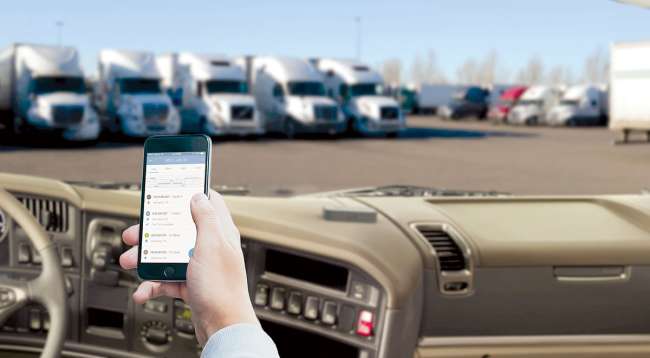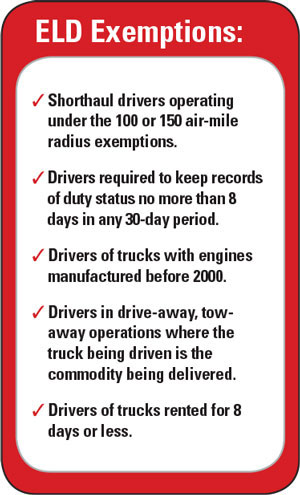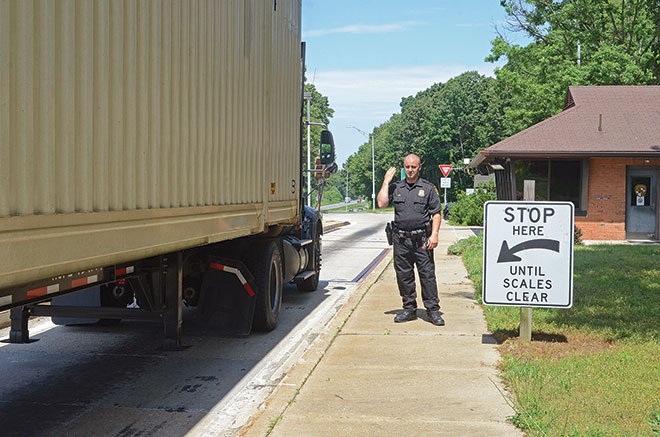Managing Editor, Features and Multimedia
Moving to ELDs: Carriers, Law Enforcement Prepare for Mandate

After years of anticipation and debate, the federal mandate of electronic logging devices is nearly here. But many trucking companies still have work to do to comply with the regulation — and the clock is ticking.
The Federal Motor Carrier Safety Administration’s final ELD rule, published in late 2015, is set to go into effect Dec. 18.
OPINION: It's time to move forward with the ELD mandate
RESOURCES: Websites provide product reviews to help carriers make ELD choices
YOUR GUIDE TO THE MANDATE: Downloadable PDF.
The regulation will require carriers to record drivers’ hours of service with ELDs rather than paper logbooks, a change that proponents say will help make the trucking industry safer by better enforcing HOS limits.
Telematics industry analyst Clem Driscoll, founder of research and consulting firm C.J. Driscoll & Associates, said he believes most large fleets will be ELD-compliant by the implementation deadline, but that might not be the case for some smaller trucking companies.
“I think some will still be scrambling at the end of December and may not make it,” Driscoll said.
Bulk carrier Kenan Advantage Group, like many other large trucking firms, already has converted its operation to e-logs, said Kirk Altrichter, vice president of fleet services at the company.
However, fleets that have not yet deployed the technology are running out of time to prepare for the mandate if they haven’t started negotiating with ELD suppliers, Altrichter warned.
“It’s not like walking into Circuit City on Dec. 17 and just buying whatever you want,” he said.
Carriers that already do a good job of operating within HOS limits actually could see productivity gains with ELDs, Altrichter said, but “those that may have skirted some of the rules … will see things differently.”
He agreed with forecasts that freight capacity will shrink to some extent as HOS enforcement tightens under the ELD rule. “If everyone’s on the same playing field with the same playbook, then I would firmly expect that the market will tighten.”
Kenan Advantage Group, based in North Canton, Ohio, ranks No. 25 on the Transport Topics Top 100 list of the largest for-hire carriers in North America.
Analysts and technology suppliers expect demand for ELDs to spike just ahead of the Dec. 18 deadline.
Driscoll’s annual survey of U.S. fleet operators, conducted in April through June, revealed that 60% of carriers still were recording drivers’ hours with paper logbooks at that time, while 33% were using e-logs and 8% were using both or some of each. The results were based on responses from 255 carriers that are required to monitor HOS.
More than a third of respondents who had not yet installed ELDs said they would not implement until the fourth quarter, or wait as long as possible based on the regulations, Driscoll said. Among 20 owner-operators interviewed, none was using ELDs and none planned to deploy before the fourth quarter, he added.
A few respondents said they expected the ELD mandate to be overturned — a scenario that now appears highly unlikely — or weren’t planning to install ELDs at all.
“I drag my feet on everything the [Department of Transportation] hands down,” said one fleet operator with fewer than 10 trucks. “We’re small, and we slip through the cracks.”
Others see the ELD rule as an important milestone in the history of the trucking industry.
ELDs will change the way drivers interact with fleets’ back offices and with law enforcement, said Scott Sutarik, associate vice president of commercial vehicle solutions at technology supplier Geotab.
“I think it will fundamentally transform the industry,” he said, comparing the ELD mandate to deregulation in 1980.
ELDs also will remove “flexibility” with hours of service that could force carriers to alter their routes as compliance with HOS limits improves.
“It’s going to be a transition,” Sutarik said, not only for drivers but also for fleets’ planners and safety managers, as well as for DOT.
Who Must Comply?
For the most part, commercial drivers who are required to keep paper logbooks today will need to convert to ELDs under the regulation.
The rule does include several exemptions, however.

Drivers who work primarily in shorthaul operations and do not need to fill out paper logs more than eight out of 30 days can continue to keep their records of duty status on paper.
Also exempt are drivers of trucks with engines manufactured before 2000, as well as drivers in driveaway-towaway operations in which the vehicle driven is the commodity being delivered.
FMCSA also recently granted a limited ELD exemption to drivers of trucks rented for eight days or less.
The rule includes a grandfather provision that allows carriers that already have deployed current electronic logging systems classified as automatic onboard recording devices, or AOBRDs, to continue using them until Dec. 16, 2019.
However, fleets cannot simply stockpile AOBRDs ahead of the mandate.
Carriers are allowed to move their existing AOBRDs into new trucks as they replace their older vehicles, but they can’t add new AOBRDs to new capacity as they expand their fleets, said Joe DeLorenzo, director of FMCSA’s office of enforcement and compliance.
“In terms of planning how things are going to go over the next two years, I think it’s important that everyone think about that,” DeLorenzo said last month at American Trucking Associations’ Management Conference & Exhibition. “Think about what new capacity you may be adding, or whether you are just replacing vehicles.”
Kenan Advantage Group, for one, plans to continue running its AOBRDs through the grandfather period.
“They’re already integrated. It doesn’t make a lot of sense for us to wipe them out and incur additional expense for no reason,” Altrichter said.
Technology supplier PeopleNet is working to support its fleet customers as they plan to migrate from AOBRDs to ELDs.
“For so many of our customers, hours of service is not just compliance, it’s information to run their business and make decisions,” said Eric Witty, vice president of product management at PeopleNet.
Some of those fleets plan to make that transition soon, while others intend to take advantage of the grandfather clause, he said
Expanding Options
For an ELD to be valid in the eyes of FMCSA, the device must be self-certified by the vendor and listed on the agency’s online registry.
By the end of October, that list of registered ELDs had ballooned to more than 150 devices.
The ELD rule spells out two primary options for data transfer: a telematics option using web services or e-mail or a local option using Bluetooth or USB.
FMCSA’s DeLorenzo predicted that web services will be the method of choice in “an overwhelming majority of cases.”
ELDs also must be equipped to handle one of two backup data transfer methods: a graphical display that an inspector can view without entering the truck or a printout of the driver’s log data.
In the event of an ELD malfunction, motor carriers must repair or replace the device within eight days of discovering the problem. During that time, drivers can use paper logs as a backup until the ELD is back in service.
The ELD rule also allows special driving categories for personal conveyance, which counts as off-duty time, and yard moves, which can be recorded as on-duty, non-driving time.

TT File Photo
ELD Enforcement
Law enforcement will take a phased-in approach to the regulation.
The Commercial Vehicle Safety Alliance announced earlier this year that inspectors will begin enforcing the mandate as soon as it goes into effect Dec. 18 but will not place trucks out of service for operating without an ELD until April 1.
That approach will allay fears that weigh-station parking lots will fill up with noncompliant trucks when the rule goes into effect, CVSA Executive Director Collin Mooney said.
“We’re hopeful that by the time April 1 rolls around, a lot of the fears will subside,” he said at MCE.
Mooney also emphasized that the regulation will not change hours-of-service limits; it just shifts the method of enforcement from paper logs to electronic logs.
“The underlying hours-of-service rules are not changing. However, for some, this will be the first introduction to hours-of-service compliance,” he quipped.
A Winding Road
The ELD mandate has been in the works for years and has withstood challenges in court and on Capitol Hill.
The regulation was mandated by Congress in the Map-21 transportation bill passed in 2012. From there, FMCSA finalized the ELD rule in late 2015 and gave carriers two years to implement the technology.
The Owner-Operator Independent Drivers Association, a staunch opponent of the mandate, filed a lawsuit contending that mandating ELDs does not advance safety and violates Fourth Amendment rights against unreasonable searches and seizures. A U.S. appeals court denied that legal challenge, and the U.S. Supreme Court declined to hear the case.
In September, the U.S. House rejected legislation introduced by Rep. Brian Babin (R-Texas) that would have delayed the mandate by two years.
American Trucking Associations has long supported the ELD rule.
“This issue has been legislated, promulgated and litigated. And it is now time to move forward,” ATA President Chris Spear said last month at MCE. “ELD technology removes one’s ability to exceed the legal hours of service, ushering in a safe, efficient and fair playing field for the nation’s trucking industry.”
ELD Deployment
While most large fleets have already adopted or updated their technology, many smaller carriers are still making preparations, Omnitracs CEO John Graham said.
“There’s still a lot of technology adoption that’s going to occur between now and probably the early part of 2018,” he said in mid-October.
Omnitracs has seen that ramp-up in its monthly shipment volumes, which have been doubling from year-ago levels since about March, Graham said.
To prevent potential supply shortages, the company has taken steps to ensure it has the necessary inventory to support demand for its ELD platforms “well into 2018,” he added.
Although a large number of carriers still need to implement ELDs, many at least have begun the evaluation process, and some have purchased the devices, said Barrett Young, director of marketing at ELD supplier KeepTruckin.
Even so, the industry still has a long way to go, “and it’s going to come down to the wire,” Young said at the North American Commercial Vehicle Show in September. “We’re anticipating a large hockey stick — a huge increase in demand — over the next couple months. Because we’ve anticipated this, we are stocking up our inventory to make sure we can ship as many as possible to those who need it.”
That being said, it would be wise for ELD buyers to place their orders as soon as possible because of the possibility of back orders, Young said.
KeepTruckin’s product is one of many ELDs geared toward smaller fleets and owner-operators.
The system relies on a mobile app that drivers can download on their smartphones and tablets, plus a small, in-cab device that connects with the truck’s engine. The product has no upfront hardware costs but requires a monthly subscription of $20 or $30 per device, depending on the amount of features the customer chooses.
Geotab’s Sutarik agreed that much of the industry still needs to prepare for the mandate.
If too many carriers wait until the end, there’s a danger that last-minute buyers could encounter difficulty securing devices if demand surpasses the available supply of ELD hardware, he said.
“It’s a concern,” Sutarik said. “We would recommend that people who are looking to buy an ELD device purchase it well in advance of the deadline and get some experience with it, so when that date does come, they’re ready for it.”
Sutarik also warned that ELD cybersecurity should be a consideration.
Data security is not an element of the ELD rule, so it will be up to the device suppliers to prevent security breaches, he said.
Transervice, a provider of full-service leasing, dedicated carriage and logistics services, uses its onboard technology to support not only e-logs but also a variety of other telematics and data services to boost fleet efficiency.
Tom Poduch, director of logistics design at Transervice, encouraged first-time adopters of e-logs to consider opportunities to improve their operations, rather than focusing solely on basic ELD compliance.
“Don’t be afraid of the technology,” he said.



